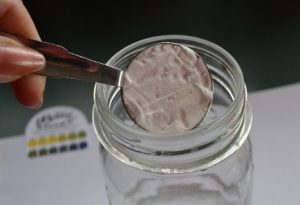I’ve spent more time than I would ever have imagined on experimenting with making washing soda by heating baking soda in my oven. I thought that today I’d give you a summary of how to make washing soda and some secrets to determining when the process is complete.
Why make your own washing soda? Because it’s often hard to find in the store. And because if you do it right, you can easily make it for less than the cost of commercial washing soda.
So here is the very simple process – How to Make Washing Soda
 You will need a glass casserole dish (or other oven proof dish) and about two cups of baking soda. The dish must be glass because the washing soda will react with metal pans, especially aluminum, and may damage the pan.
You will need a glass casserole dish (or other oven proof dish) and about two cups of baking soda. The dish must be glass because the washing soda will react with metal pans, especially aluminum, and may damage the pan.
Put the baking soda in an even layer in the casserole dish. Use about two cups, or whatever quantity makes about a 1″ thick (or smaller) layer in your pan. The thicker the layer, the longer it will need to be heated and the more it will need to be stirred while heating.
Now place the baking soda dish in the top rack of your oven. Leave it there while you do your normal cooking. Leave it there even when the oven is off. Every few times you use the oven, take the dish out and stir the baking soda and put the dish back in the oven.
Let the baking soda sit in the oven for a week or so until you have about six cumulative hours of heating the oven to 375 degrees or higher. By then it should have converted to washing soda.
Although it works to simply heat the baking soda alone for about 3 hours at 375 degrees, I don’t recommend this because the expense of heating your (gas) oven for 3 hours would be about $.34 an hour for a total of $1.02. That would actually make your homemade washing soda cost more than the washing soda you could purchase in the store.
If you could find it in the store, that is.
If you normally cook at temperatures above 400 degrees F, then you may find that your baking soda converts faster. You may also need less time if you start with very small quantities of baking soda.
Use the tests below to determine when you actually have washing soda. If your tests show it has not converted yet, just put it back in the oven and continue heating.
How can you tell if your baking soda has converted to washing soda?
There are several ways that will help you determine if you have made washing soda:
Secret 1: The volume of the soda has increased. Heating about 2 cups of baking soda will convert to about 2-1/2 cups of washing soda.
If the volume has not increased, put it back in the oven for more heating.
Secret 2: Dissolve a tablespoon of the powder in about 1/2 cup of clear water. Washing soda will dissolve quickly and stay dissolved. Baking soda will need to be shaken, stirred, shaken again to get it to dissolve.
Then let the solution sit for about 15 minutes. The washing soda solution will stay clear. The baking soda solution will develop a layer of white powder on the bottom of the cup after 10-15 minutes. That’s because you thought the baking soda dissolved in the water, when in fact it was just fooling you.
Secret 3: Look closely at the texture and color of the powder. Baking soda is a brilliant white and the particles look like very tiny grains of white sand or sugar. Washing soda has a subtle gray cast (compare it to unheated baking soda) and the texture is more powdery, like a fine talcum powder.
The difference is subtle, so don’t be discouraged if you feel that you are just guessing that the color and texture has changed.
Secret 4: Do a pH test on the washing soda. Dissolve the washing soda in a 1/2 cup of filtered water. The washing soda solution should test alkaline with a pH of 11.6.
Here is a photo of baking soda:
And here is a photo of washing soda:
Once you’ve made the washing soda, keep it in a sealed container. I use a 32 oz size yogurt container, but you could use a zippered plastic bag, a clean jar, or any container with a lid.
To boost your laundry detergent, use about 1/4 to 1/2 cup of washing soda per load. It can also be used as a heavy-duty cleaner – just mix with a little water to make a paste or more water to make a spray solution.
Remember that washing soda is caustic. With a pH of 11.6 it is more alkaline than ammonia which has a pH of 11.5. Bleach has a pH of 12.6. Don’t let washing soda powder or solution come in contact with your skin.
You can read the details of my seriously flawed pH test and the later successful pH test as I tried to determine whether I had actually converted the baking soda to washing soda.
Enjoy the process and savor the savings! That’s The Fat Dollar way.



